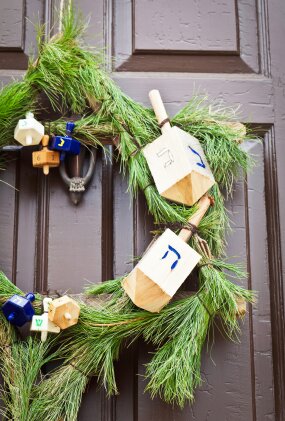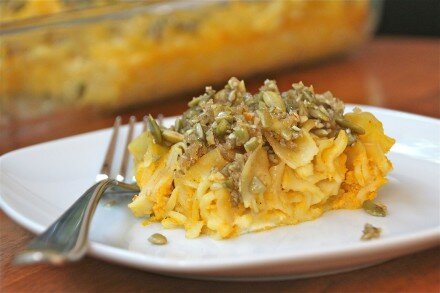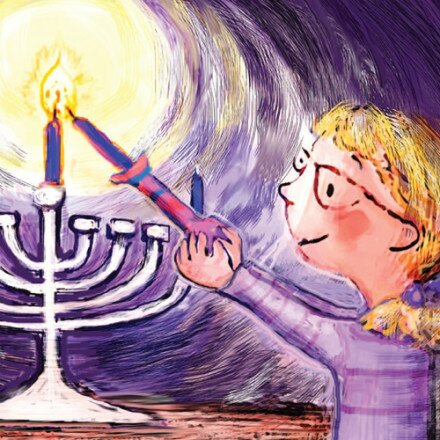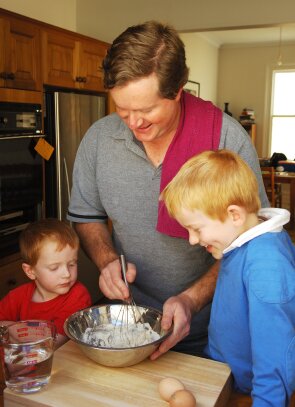By Rebecca Cynamon-Murphy
 My family has always had a Thanksgivukkah tradition. Our local Whole Foods usually makes a special purchase of vegan, kosher marshmallows to top Thanksgiving sweet-potato casseroles. We always buy several bags—along with fair-trade chocolate coins in bulk—to also make s’mores for Hanukkah in our toaster oven. This year, as we celebrate both holidays on the same day, we look forward to our holiday s’mores, as well as preparing to make our usual Thanksgiving guests comfortable with celebrating our Jewish holiday alongside us.
My family has always had a Thanksgivukkah tradition. Our local Whole Foods usually makes a special purchase of vegan, kosher marshmallows to top Thanksgiving sweet-potato casseroles. We always buy several bags—along with fair-trade chocolate coins in bulk—to also make s’mores for Hanukkah in our toaster oven. This year, as we celebrate both holidays on the same day, we look forward to our holiday s’mores, as well as preparing to make our usual Thanksgiving guests comfortable with celebrating our Jewish holiday alongside us.
As you start to think about your holiday plans, you might find that while Thanksgiving is normally a convergence of certain friends or family members, and Hanukkah is normally celebrated with other loved ones, this dual holiday will bring new people together. You might be at your in-laws’ house as usual for Thanksgiving, but this is the first time they will be celebrating Hanukkah. Or your children, who are just starting to grasp the meaning of each holiday, will have double the excitement on the second night of the Festival of Lights. Whomever you are celebrating with, it should be a fun and meaningful experience. Here are a few things to think about as you plan for your gathering, whether you’re a host or a guest.
Be a Hospitable Host
Consider sending a detailed email or having conversations with your guests to make clear any changes to the conventional Thanksgiving. Do you serve kosher meals on Jewish holidays? Will you light the candles of your menorah? Will guests bring their own to light? Will only the children light? Will gifts be given? Who gives to whom? What type of presents are usually exchanged?
At the gathering, practice the great Jewish tradition of teaching as we celebrate, and be prepared to provide translations of prayers, an easy-to-tell version of the miracle being celebrated, explanations of holiday foods, instructions for playing dreidel and even stories from your family’s previous celebrations to help guests get in the spirit. (And provide all of the necessary materials.)
Before the meal, consider altering prayers to be inclusive of all attendees. For instance, my father is Christian and usually concludes prayers with the phrase, “In Jesus’s name, amen.” When any of his children who are not Christian are present, he instead thanks God for Jesus within the prayer so that all can join him in the “amen” without feeling that they will have to pray in Jesus’s name. Examine your own prayer habits for similar ways you can encourage others to practice alongside you.
Be the Gracious Guest
If you’ll be guests in a home that isn’t Jewish (and you won’t be home before sundown), it is perfectly OK to call the host and discuss accommodations for your religious practice. If you are uncomfortable with prayers to the Trinity, work out a diplomatic way to share this. If you want to light candles and say the blessings, find out if your host is comfortable with that and, if so, offer to bring your usual holiday set-up and ask if you should bring extras so everyone can participate. Most people will be comfortable with this, but it’s also OK to politely explain that you will need to leave early.
My family keeps kosher, and I explain to friends that if there are vegetarian options, we will be fine, although sometimes folks need reminding that chicken broth and bacon fat make a dish no longer veggie-friendly. Consider bringing a dish to share.
Blend Traditions
Since one of the two is a civic holiday in this dual celebration, much of the discomfort that many people feel about Christmas and Hanukkah mash-ups should not be an issue. Feel free to make sweet potato latkes served with cranberry sauce and whipped cream, and stuff your turkey with challah. Create menorahs from the “Three Maidens” (squash, beans and corn). Place the pilgrim figurines amongst the lit candles in the windowsill.
Try Something New
Level the playing field for those who are and aren’t Jewish by trying out a new celebration. After we were invited to a sufganiyot (doughnut) party one year, we adopted it into our own tradition. I prep during the day to make a basic yeast dough, then set up stations around the kitchen with a list of steps for my guests to follow. I retire to the living room with a glass of wine and the children while my husband and our guests figure out an assembly line to roll the dough, cut circles, fry them, roll them in sugar and fill them with jelly. Or, if you and your guests play cards, consider learning Kvitlech in addition to playing dreidel.
If you’d like to keep festivities a little more Thanksgiving-flavored, consider simply keeping it kosher this year. Trader Joe’s has traditionally carried kosher turkeys and brisket, or you can make a journey to find a kosher butcher. This would mean eliminating all dairy from your meal (including butter), as well as shellfish and pork. The effort to find new side dishes that highlight delicious ingredients with olive oil and crunchy salt instead of heavy cream and cheese will set this meal apart from other Thanksgivings as something special and out-of-the-ordinary. Dessert can either wait to be eaten until the meal has been over for two hours or be dairy-free as well. Eggs and mayonnaise are considered pareve (containing neither dairy nor meat), so your leftover sandwiches are in the clear too.
Be Kid-Friendly
As my husband says, “Hanukkah is not a meal holiday.” So spend some time doing something other than eating together to give the holy day its due. Pull together a mix of popular Hanukkah songs (see my suggestions below!) or spend some time teaching children the Hebrew words for the traditional blessings, which are often sung. Pinterest has opened up a world of ideas for crafts, from origami Stars of David to hand-printed menorahs to gelt bags. Of course, playing dreidel is simple enough for even the smallest children, and buttons or trinkets can replace gelt if you are uncomfortable with using play money.
Ask the kids to put together a special pageant commemorating the shared holidays. Provide a dress-up box to help their creativity along. Although Lemony Snicket’s “The Latke Who Couldn’t Stop Screaming: A Christmas Story” is my favorite book for its sympathetic, clever and humorous treatment of the angst so many Jewish people feel when Hanukkah is associated with Christmas, there are other great books for kids that are less December-oriented. By reading them, kids leave your Thanksgiving celebration knowing that the Jewish holiday celebrated on that same day is about more than just its symbols. “Hanukkah at Valley Forge” by Stephen Krensky and Greg Harlin is a great example.
As the nights grow longer and colder, most of us need to be reminded in some way that a higher power keeps the light shining and the harvest coming. Thanksgiving allows us to take a moment to remember how much gratitude is owed to the work of others: the farmers, migrant workers, truck drivers, grocers and cooks. We are powerfully reminded that our life is dependent on others for its basic sustenance. Hanukkah reminds us that we are similarly dependent upon God for miracles. It seems right by more than just the calendar that these two sentiments should be celebrated together every once in awhile.
Rebecca’s Top 10 Interfaith Hanukkah Tunes
- “Hanukkah Blessings” by Barenaked Ladies
- “Happy Joyous Hanukkah” by Indigo Girls
- “The Chanukah Song” by Adam Sandler
- “Miracle” by Matisyahu
- “Hanukkah Oh Hanukkah” by the “Glee” Cast
- “Feast of Lights” by They Might Be Giants
- “Can I Interest You in Hanukkah?” by Stephen Colbert and Jon Stewart
- “Rock of Ages—Ma’oz Tzur” by Marc Cohn
- “Hanukkah Dance” by The Klezmatics
- “Nun Gimmel Heh Shin” by The LeeVees
Rebecca Cynamon-Murphy is the Christian partner in an interfaith marriage. Both she and her Jewish husband practice their faiths individually and share what they can of each other’s traditions. She considers this lifelong process of cultural and personal reconciliation fulfillment of God’s consistent commandment to mend the world. She has degrees in English and public policy and is currently spending the majority of her days reading books to her toddler.
Reprinted with permission from InterfaithFamily. Additional Hanukkah resources can be found here.
















Don’t forget about the official Thanksgivukkah anthem: https://soundcloud.com/rabbidavid/thanksgivukkah!